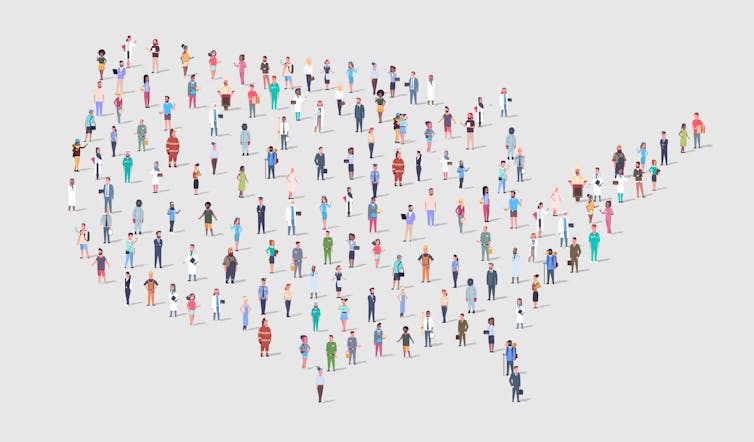Overweight and obesity rates are rising in all age ranges across the U.S.
Marie Ng, University of Washington
Nearly half of adolescents and three-quarters of adults in the U.S. were classified as being clinically overweight or obese in 2021. The rates have more than doubled compared with 1990.
Without urgent intervention, our study forecasts that more than 80% of adults and close to 60% of adolescents will be classified as overweight or obese by 2050. These are the key findings of our recent study, published in the journal The Lancet.
Synthesizing body mass index data from 132 unique sources in the U.S., including national and state-representative surveys, we examined the historical trend of obesity and the condition of being overweight from 1990 to 2021 and forecast estimates through 2050.
For people 18 and older, the condition health researchers refer to as “overweight” was defined as having a body mass index, or BMI, of 25 kilograms per square meter (kg/m²) to less than 30 kg/m² and obesity as a BMI of 30 kg/m² or higher. For those younger than 18, we based definitions on the International Obesity Task Force criteria.
This study was conducted by the Global Burden of Disease Study 2021 U.S. Obesity Forecasting Collaborator Group, which comprises over 300 experts and researchers specializing in obesity.

Why it matters
The U.S. already has one of the highest rates of obesity and people who are overweight globally. Our study estimated that in 2021, a total of 208 million people in the U.S. were medically classified as overweight or obese.
Obesity has slowed health improvements and life expectancy in the U.S. compared with other high-income nations. Previous research showed that obesity accounted for 335,000 deaths in 2021 alone and is one of the most dominant and fastest-growing risk factors for poor health and early death. Obesity increases the risk of diabetes, heart attack, stroke, cancer and mental health disorders.
The economic implications of obesity are also profound. A report by Republican members of the Joint Economic Committee of the U.S. Congress, published in 2024, predicted that obesity-related health care costs will rise to US$9.1 trillion over the next decade.
The rise in childhood and adolescent obesity is particularly concerning, with the rate of obesity more than doubling among adolescents ages 15 to 24 since 1990. Data from the National Health and Nutrition Examination Survey revealed that nearly 20% of children and adolescents in the U.S. ages 2 to 19 live with obesity.
By 2050, our forecast results suggest that 1 in 5 children and 1 in 3 adolescents will experience obesity. The increase in obesity among children and adolescents not only triggers the early onset of chronic diseases but also negatively affects mental health, social interactions and physical functioning.
What other research is being done
Our research highlighted substantial geographical disparities in overweight and obesity prevalence across states, with southern U.S. states observing some of the highest rates.
Other studies on obesity in the United States have also underscored significant socioeconomic, racial and ethnic disparities. Previous studies suggest that Black and Hispanic populations exhibit higher obesity rates compared with their white counterparts. These disparities are further exacerbated by systemic barriers, including discrimination, unequal access to education, health care and economic inequities.
Another active area of research involves identifying effective obesity interventions, including a recent study in Seattle demonstrating that taxation on sweetened beverages reduced average body mass index among children. Various community-based studies also investigated initiatives aimed at increasing access to physical activity and healthy foods, particularly in underserved areas.
Clinical research has been actively exploring new anti-obesity medications and continuously monitoring the effectiveness and safety of current medications.
Furthermore, there is a growing body of research examining technology-driven behavioral interventions, such as mobile health apps, to support weight management. However, whether many of these programs are scalable and sustainable is not yet clear. This gap hinders the broader adoption and adaptation of effective interventions, limiting their potential impact at the population level.
What’s next
Our study forecasts trends in overweight and obesity prevalence over the next three decades, from 2022 to 2050, assuming no action is taken.
With the advent of new-generation anti-obesity medications, obesity management could change substantially. However, the extent of this impact will depend on factors such as cost, accessibility, coverage, long-term efficacy and variability in individual responses. Future research will need to leverage the most up-to-date evidence.
The Research Brief is a short take on interesting academic work.![]()
Marie Ng, Affiliate Associate Professor of Global Health, University of Washington
This article is republished from The Conversation under a Creative Commons license. Read the original article.




























































